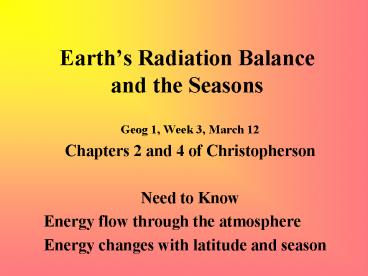Earths Radiation Balance and the Seasons - PowerPoint PPT Presentation
1 / 17
Title:
Earths Radiation Balance and the Seasons
Description:
Chapters 2 and 4 of Christopherson. Need to Know. Energy flow ... Some trivia: Australians each use about. 250GJ fossil fuel per year, = about 6m2 in Hobart ... – PowerPoint PPT presentation
Number of Views:46
Avg rating:3.0/5.0
Title: Earths Radiation Balance and the Seasons
1
Earths Radiation Balance and the Seasons
- Geog 1, Week 3, March 12
- Chapters 2 and 4 of Christopherson
- Need to Know
- Energy flow through the atmosphere
- Energy changes with latitude and season
2
-270oC
6000oC
15oC
EQUILBRIUM
What is the incoming and outgoing radiation?
3
Wavelength in micro-metres (microns or ?m)
0.01
103
10-8
0.4-0.7
106
?-rays
X-rays
UV
Infrared
Microwave
Radio
10?m infrared
Peak energy output at 20oC
Visible spectrum Peak energy output of sun
4
24 absorbed in atmosphere
10,000 times more energy than we use
31 reflected
45 absorbed at surface
5
Incoming Solar Radiation
- Top of atmosphere, solar constant 1.37kW/m2
- 5.5x1024 J/year (humans use 4x1020 J/year)
- Full sun at surface, facing sun, 1kW/m2
- But due to clouds, absorption, scattering only
about 25 of sunlight, on average, reaches
surface - At one location only daylight ½ the time
6
From Christopherson p89
Hobart 135W/m2
Some trivia Australians each use about 250GJ
fossil fuel per year, about 6m2 in Hobart
7
All the energy absorbed by the air and surface is
radiated back out into space
Radiation
Convection
Evaporation/ Condensation (latent heat)
8
Outgoing Radiation
- Infrared with a peak intensity at about 10?m
- Gases such as CO2 absorb some of this infrared
radiation, hence concern about global warming - Cloudy night is warmer because radiation cannot
escape to space
9
From Christopherson p95
10
Part 2
- Having discussed radiation in and out
- Now it is important to consider the effect of
latitude on heating of the surface - And the fact that the tilt of the Earths axis
means different latitudes will get more or less
radiation at different times of the year.
11
(No Transcript)
12
The Seasons
- Solar System
- Earth about 150,000km from sun
13
Above Arctic Circle no sun
23.5o
71o
43oS
Hobart 21 Dec. Day 15 h long
South Pole no night
14
24o
Hobart 21 June Day 9 h long
15
71o
24o
E
W
N
Summer and Winter Sun Paths for Hobart Very
important for solar house design
16
Summary
- Radiation from sun
- Radiation from Earth
- More incoming energy near equator
- Earths tilt- seasons
17
Next Week
- Global Circulation (Synoptic Winds)
- Chapter 6 of Christopherson
- Especially pages 140 to 155































